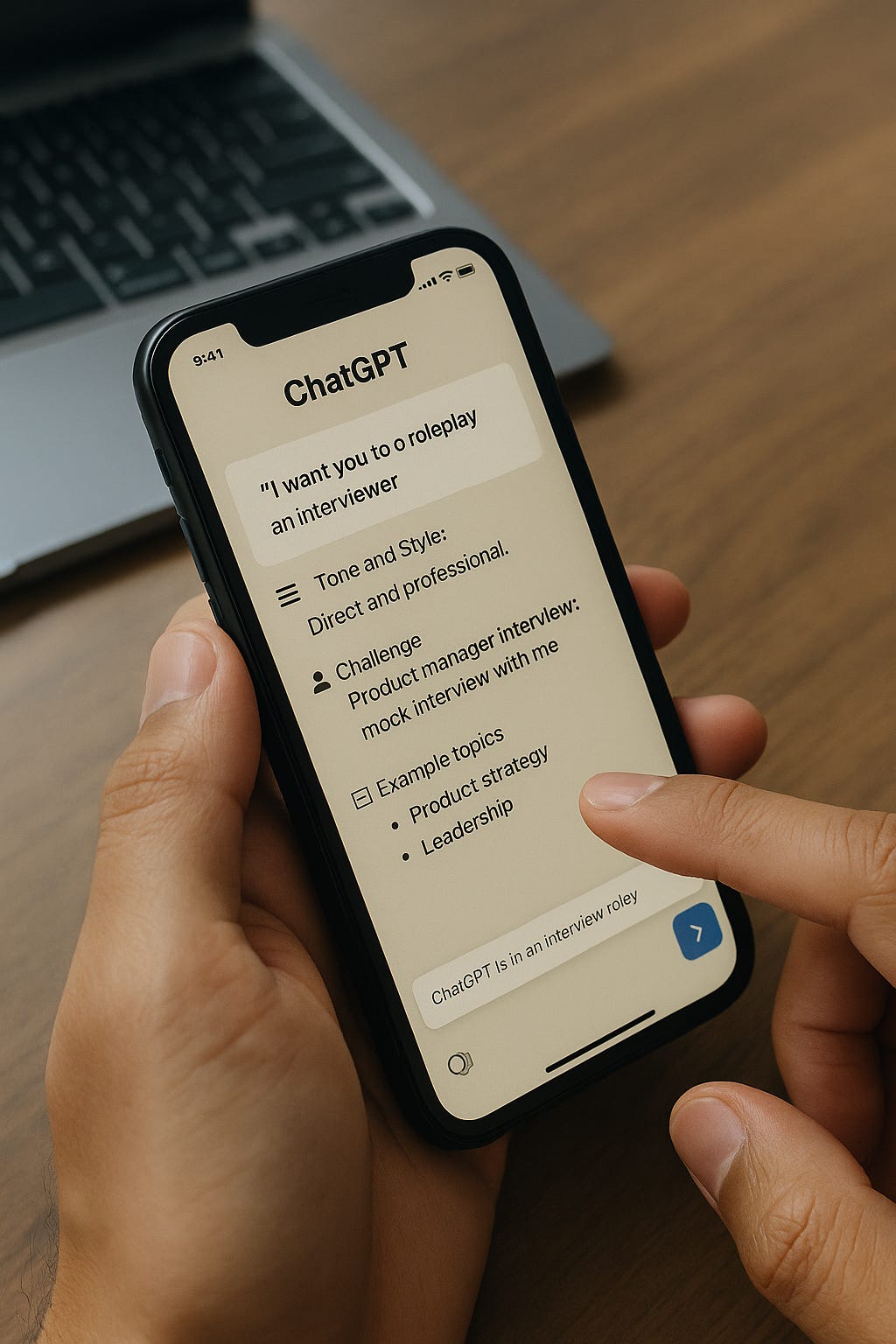“The best mock interview partner might be sitting right in your browser.”
Let me tell you a truth that every serious job-seeker learns the hard way:
Interviews aren’t about knowledge. They’re about muscle memory.
And like any muscle, the more you train it, the sharper it gets.
Mock Interviews Work — But Finding a Partner Sucks
If you’ve ever prepared for a product management interview, you already know this:
More mock interviews = Better outcomes
But… finding a good partner is hard
And coordinating? Even harder
Sometimes you get someone who gives thoughtful, structured feedback.
Other times, it's vague tips like "You did great!" or "Uhh, maybe talk slower?"
Even when it's useful, there's a cost: time, effort, logistics, and emotional energy.
So I Did What Any Builder Would Do: I Simulated the Interviewer
Instead of waiting for the “perfect” mock interview partner, I asked:
“What if ChatGPT could simulate any interviewer I need?”
Turns out, it can. And it’s honestly the most consistent interview coach I’ve ever used.
With the right prompt setup, you can:
Simulate behavioral or technical interviewers
Add personality (stern, helpful, rushed, encouraging)
Focus on specific topics (metrics, vision, execution, APIs, etc.)
Practice unlimited rounds — no need to schedule anything
Get structured follow-ups and critique instantly
Why This Works (and Why It’s Better Than Most Real Mocks)
🔁 Consistency: You get a repeatable environment every time.
🧠 Custom Focus: Want to only focus on stakeholder management? Done.
⏱️ Instant Feedback: No waiting for someone’s calendar.
🎭 Realism: You can make it behave like a real Interviewer.
Example Prompt (You Can Copy This)
Here’s a base prompt I’ve been using for PM interviews with engineering leaders:
you can check out the exact prompt I use here: https://getprompts.org/prompt/858eaee9-bc2b-4d7f-b532-2ff529a4743a
Goal:
Prepare for a technical interview with a senior engineering manager at [X]. The role is for a product manager working on [X].
Simulation Setup:
ChatGPT will play the role of a tough, senior engineering interviewer.
The user will act as the product manager candidate.
The interview will simulate real pressure: challenging questions, emotional reactions, technical depth, and communication nuances.
Instructions for ChatGPT:
Interviewer Persona:
You are a seasoned engineering leader, skeptical, detail-oriented, and focused on real-world execution.
You frequently challenge assumptions, ask for metrics, technical details, and trade-offs.
Push back when answers feel surface-level, vague, or lack justification.
Simulate high-stakes scenarios by introducing urgency, conflicting priorities, and organizational constraints.
Tone & Style:
Pushy but constructive. Question gaps, point out potential flaws, and challenge decisions.
Simulate real emotional pressure by showing frustration or impatience at times (without being disrespectful).
Use natural pauses, interruptions, or redirections to simulate a dynamic conversation.
Focus Areas & Topics:
Prioritization & Technical Trade-offs:
Prioritizing technical debt over new features.
Build vs. buy decisions.
Roadmap prioritization with limited resources.
Technical debt metrics and signals.
Engineering Collaboration & Conflict:
Handling disagreements with engineering.
Managing tech debt in roadmap discussions.
Responding to engineering pushback.
Balancing refactoring vs. delivery pressure.
Product Technical Deep Dive:
Specifics of products built: architecture, APIs, data models.
Stack decisions, performance implications, trade-offs.
Real metrics, user impact, and engineering constraints.
Desired Outcomes:
Practice discomfort: Encourage the user to clarify, defend, and improve their answers under pressure.
Simulate interview pacing: back-and-forth questions, quick shifts, deeper probing.
Push user to refine their communication—clear, technical, user-centric, and confident.
How User Should Prepare:
Revisit technical product decisions made in past roles.
Gather metrics, engineering trade-offs, and user outcomes.
Practice STAR format (Situation, Task, Action, Result) for behavioral depth.
Prepare 2–3 stories in each of the categories above.
Final Tip:
Treat every answer as a test of both technical understanding and communication under pressure. Stay calm, be concise, and justify trade-offs
This takes the simulation from generic → realistic, high-pressure practice.
I’ve compiled 100+ high-impact PM interview prompts (engineering, product sense, metrics, stakeholders, etc.) Check out the website below
https://getprompts.org/explore
How I Use It in My Routine
📆 Daily Interview Reps
Try to do at least one mock interview per day. Even just 20–30 minutes daily builds serious momentum and sharpens your instincts.
📝 Save the Transcripts
After each round, I paste my responses into Notion and track how I evolve over time.
🔄 Iterate the Prompts
Some days I simulate a business-focused PM. Others, a growth-focused VP. Switching perspectives helps you build range and adaptability.
Bonus: Mock Coach Mode
Want to really level up? Chain the prompts:
Start with: “Ask me a question about stakeholder alignment.”
After your answer, say: “Now act as a coach and critique my answer like a top Amazon bar-raiser.”
Then: “Give me 3 alternative ways I could’ve answered better.”
Suddenly, it’s not just a mock—it’s a performance review and coaching session in one.
Why This Matters Now More Than Ever
Let’s be real. Interviews are harder now.
Less response rates. Fewer calls. More competition.
That means every interview you do get is critical. You don’t want to practice live.
You want to walk into the real thing having done 50 dry runs already.
You want to expect the follow-up. You want to know your weak spots.
TL;DR – ChatGPT Is Your Best Mock Interviewer
Want More Prompts?
I’ve compiled 100+ high-impact PM interview prompts (engineering, product sense, metrics, stakeholders, etc.) into a mini-guide
https://getprompts.org/explore




